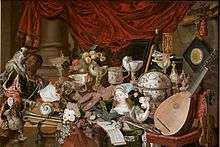The Paston Treasure

The Paston Treasure is a large oil on canvas painting and historically rare record of a cabinet of treasures in British collecting. Commissioned by Sir Robert Paston in the early 1670's it depicts some of the Paston family's collected treasures. The painting was executed by an unknown Dutch artist who sojourned at the Paston family residence at Oxnead Hall near Aylsham in Norfolk in order to complete the commission.[1]
The objects were collected by Robert and his father, Sir William Paston (c.1610–1663) who made acquisitions on a long journey travelling through Europe and on to Cairo and Jerusalem. The collection consisted of over 200 objects and included many natural curiosities made into decorative art objects, such as mounted seashells and ostrich eggs. The painting features artefacts which represent a microcosm of the known world in the mid-17th century, as hinted by the prominent position of a globe. These include - a packet of tobacco from America, a boy and parrot from Africa and a porcelain dish from Asia. Sculptures and gems, gold, silver and enamel, as well as natural history specimens, along with music instruments including a bass viol, sackbut, violin and lute can also be seen.
The peaches, grapes and oranges, along with lobster, suggest a luxurious lifestyle. The young African servant boy is also an exotic addition to the picture. He is the earliest known portrait of an African in Norfolk by almost 200 years. The girl, is most likely Robert Paston's daughter Mary, who died of smallpox in 1676.[2][3] The inclusion of parrot and monkey is suggestive of domesticated creatures possessing faculties imitative to humans, but in contrast, lacking in reason. Both are depicted as disruptive, the monkey as if jumping onto servant's shoulder, and parrot interrupting girl from her reading of song-book music.
The collection was sold shortly after the painting was finished because of the Paston's failing finances. The objects were to spread around the world again. The Paston Treasure was acquired by Norwich Castle Museum in 1947 where it, along with strombus shell with the enamelled mount is currently on display as part of the Norwich Castle Museum Collection. The nautilus shell behind the globe is in the Prinsenhof Museum in Delft and the flask held by the boy is in The Metropolitan Museum of Art in New York. The silver gilt flagon, with a visible date-mark for 1597-8 is one of a pair in the Untermeyer Collection, New York and the silver nautilus cup with the seated stem figure is now at the Rijksmuseum, Amsterdam.
The Paston Treasure functions as a work of art on several levels. Firstly, as a schatzkammer (cabinet of treasures) or Wunderkammer displaying the Paston family's wealth and learning. Secondly, as an example of the tradition of Dutch Golden Age Pronkstilleven painting, in which objects refer to the transience and emptiness of wealth and possessions, and the ultimate extinction and emptiness of earthly life. This thematic concern is developed further in a near comprehensive inventory of Vanitas symbols with its allusions to the fragility of life, the passing of time and the inevitability of death, represented here by ephemeral roses and fruit, a clock, hourglass and an extinguished candle.
The importance of The Paston Treasure lies in the international scope and interest of the objects portrayed, reflecting both exotic nature and the skills of man. It is to be the subject of an exhibition in 2018 in which Norwich Castle Museum in partnership with the Yale Centre for British Art in the USA, are planning to reunite as many of the objects depicted for the first time in 350 years.[4]
The Paston Treasure is the subject of a forthcoming book by senior research scientist, conservator and art-historian, Spike Bucklow.[5]
References
- ↑ Previously attributed to either Franciscus Gijsbrechts or Pieter Gerritsz van Roestraten a Dutch painter active in England from 1666.
- ↑ https://www.nationalgallery.org.uk/initial-teacher-education/primary/learning/unknown.aspx
- ↑ http://www.museums.norfolk.gov.uk/view/NCC151986
- ↑ http://www.eastangliaartfund.org.uk/exhibitions/the-paston-treasure-microcosm-of-the-known-world
- ↑ http://events.stanford.edu/events/581/58105/